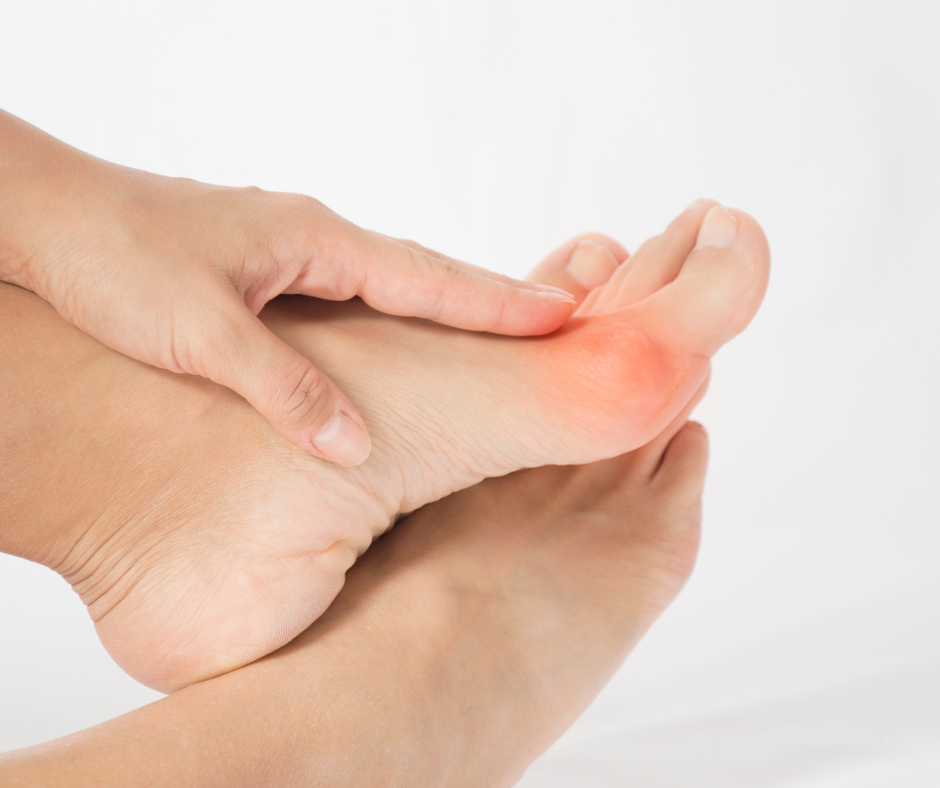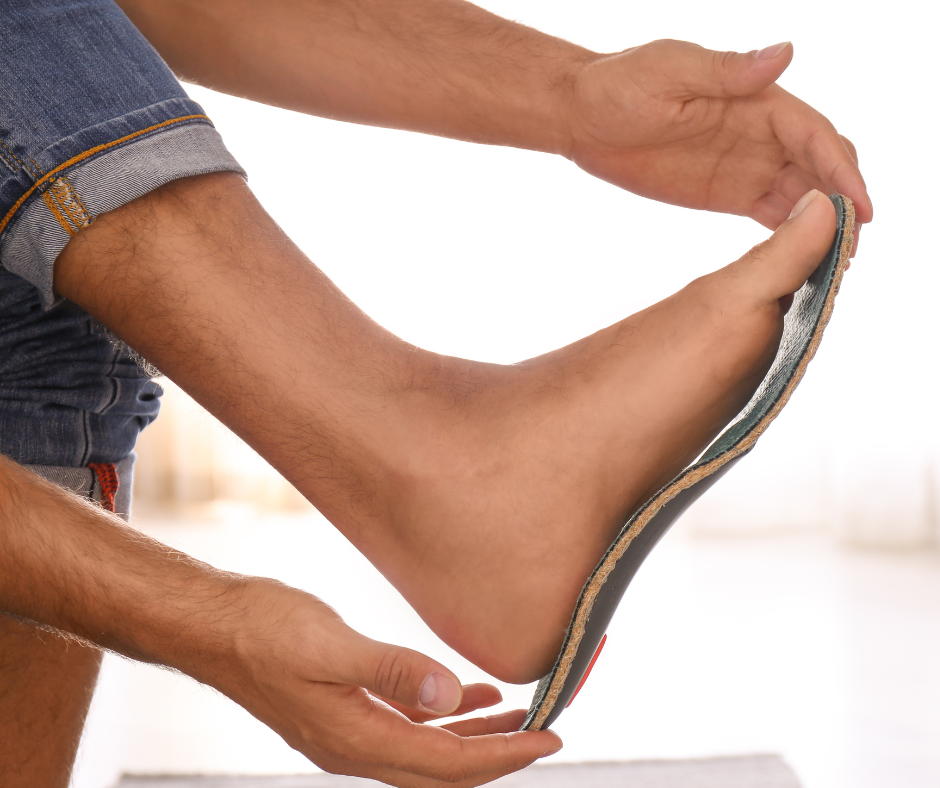-
Bunion Basics: Understanding That Bump on Your Foot

It’s a typical day…until you put on your shoes. That’s when you notice a bony bump forming at the base of your big toe. What is it? How did it get there? And why does it seem to be “drifting” towards your second toe?
If this sounds familiar, you might be dealing with a bunion, medically known as Hallux Valgus. To keep you informed on why bunions form and what to watch for, Kentlands Foot & Ankle Center is breaking down the basics below.
What’s a Bunion?
A bunion isn’t just an overgrowth of bone. It represents a change in the actual bony framework of the front part of your foot.
- The long bone connected to the big toe (the first metatarsal) starts to drift outward, and the big toe itself begins to point inward towards the smaller toes.
- This misalignment creates the characteristic bump on the side of the foot at the base of the big toe.
Bunions are often progressive, meaning they tend to get worse over time if not managed appropriately.
Why Do Bunions Form?
While ill-fitting footwear gets a lot of blame, the primary cause of bunions is usually:
- Heredity: The biggest factor! Certain inherited foot types and faulty foot mechanics (like excessive pronation or flat feet) make you more susceptible to developing bunions. If your parents or grandparents had bunions, you might be more likely to develop them, too.
- Foot Structure & Biomechanics: The way your foot functions when you walk can place abnormal stress on the big toe joint, contributing to the deformity over time.
- Footwear (The Aggravator): While usually not the root cause, shoes that are tight, narrow, or have high heels can definitely aggravate an existing bunion and potentially accelerate its progression. They force the toes into an unnatural position.
Less common causes can include foot injuries or certain types of arthritis.
Spotting the Signs: Bunion Symptom Checklist
How do you know if that bump is truly a bunion? Look for these common signs:
- The Bump: A bony prominence on the side of your foot at the base of the big toe.
- Toe Drift: Your big toe angling towards your second toe.
- Pain or Soreness: Discomfort around the big toe joint, often worse when wearing shoes or after activity.
- Redness & Swelling: Inflammation around the bony bump.
- Corns or Calluses: These can develop on the bump itself, between the big and second toes, or even on the ball of the foot due to altered pressure.
- Restricted Motion: Decreased flexibility or stiffness in your big toe joint.
- Difficulty Fitting Shoes: Finding shoes that are comfortable and don’t irritate the affected area.
Diagnosis Matters!
Even if your bunion isn’t causing significant pain yet, early evaluation allows us to confirm the diagnosis, rule out other conditions, and plan the best course of treatment for your unique needs. Affected? Don’t suffer in silence. Schedule your appointment and move toward relief today!
Interested in learning more? We’re always happy to help! Schedule a comprehensive foot examination with Kentlands Foot & Ankle Center podiatrist Dr. Jon M. Sherman. To make your appointment, please call our office at 301-825-9697.
-
Custom Orthotics, Biomechanics, and You: Step into Better Health with 3D Scanning

Our feet are the foundation of our bodies, and proper biomechanics – the way our muscles, bones, and joints work together – are essential for pain-free movement and overall well-being.
Custom orthotics can play a vital role in optimizing your biomechanics, and advancements in 3D scanning technology are revolutionizing the way these supportive devices are created. In this post, Kentlands Foot & Ankle Center explains how new tech is providing orthotics that are better than ever for all kinds of issues, so read on to learn more!
Understanding Biomechanics
When your feet don’t function optimally, it can throw off your entire body’s alignment. This can lead to a variety of issues, including:
- Foot Pain: Plantar fasciitis, heel spurs, bunions, and metatarsalgia.
- Knee Pain: Misalignment leading to patellofemoral pain syndrome or IT band syndrome.
- Hip and Back Pain: Caused by altered gait and posture.
- Balance Problems: Increased risk of falls, especially in older adults.
- Sports Injuries: Stress fractures, shin splints, and Achilles tendonitis.
Custom Orthotics: Tailored Support for Your Unique Needs
Unlike over-the-counter inserts, custom orthotics are specifically designed to address your individual foot structure and biomechanical imbalances. They provide targeted support and cushioning, helping to:
- Improve Weight Distribution: Evenly distribute pressure across your feet, reducing stress on specific areas.
- Enhance Balance and Stability: Provide a stable base of support, improving balance and reducing the risk of falls.
- Correct Gait Abnormalities: Guide your feet into a more natural and efficient gait pattern.
- Prevent and Aid Recovery from Sports Injuries: Offer shock absorption and support to reduce strain on joints and soft tissues.
The 3D Advantage: Precision and Personalization
Traditional methods of creating orthotics, like plaster casting, can be messy and imprecise. 3D scanners, on the other hand, can capture a highly accurate digital model of your feet in seconds, providing a detailed blueprint for crafting truly customized orthotics.
- Superior Accuracy: 3D scans capture the intricate contours of your feet with unparalleled precision.
- Dynamic Assessment: Some advanced scanners can even analyze your gait while you walk or run, providing a dynamic assessment of your foot function.
- Faster Turnaround: Digital models can be instantly sent to the lab, speeding up the fabrication process.
The result? A pair of custom orthotics that fit your feet like a glove, providing optimal support and comfort in one.
Interested in learning more? We’re always happy to help! Schedule a comprehensive foot examination with Kentlands Foot & Ankle Center podiatrist Dr. Jon M. Sherman. To make your appointment, please call our office at 301-825-9697.
-
ESWT Shockwave Therapy Offers a New Approach
Chronic heel pain can make everyday activities like walking and standing unbearable, and while traditional treatments like stretching, orthotics, or injections might provide some relief, they can sometimes fall short.
Enter ESWT (Extracorporeal Shock Wave Therapy), a non-invasive alternative that’s changing the game for heel pain sufferers! Kentlands Foot & Ankle Center is always at the forefront of innovative, non-invasive options, and for this blog post, we’re going to cover all the ins and outs of this exciting option, including why it might be the right choice for you.
The Limitations of Traditional Approaches
Traditional treatments for heel pain, such as physical therapy and the use of orthotics, can be helpful in the initial stages.
- However, they often provide only temporary relief and may not address the underlying cause of the pain.
- In some cases, these treatments can be time-consuming, require a long recovery period, or have unwanted side effects.
ESWT: A Non-Invasive Solution
ESWT is a treatment that utilizes pressure waves to stimulate healing and reduce pain and inflammation. Unlike traditional surgery, ESWT doesn’t involve incisions, anesthesia, or a lengthy recovery period. It also boasts high success rates that are clinically verified.
How ESWT Works
ESWT targets the affected tissue with high-energy pressure waves, stimulating a healing response and promoting tissue regeneration.
- This can be particularly effective for conditions like plantar fasciitis, where the plantar fascia, the thick band of tissue along the bottom of the foot, becomes inflamed.
Shockwave Therapy vs. Traditional Surgery
- No Cutting: ESWT avoids the need for incisions, reducing the risk of complications associated with surgery.
- Faster Healing: Recovery from ESWT is significantly faster. For example, traditional heel spur surgery might require between six weeks and three months for a full recovery.
- Reduced Risk: ESWT eliminates the risk of permanent nerve or joint damage associated with some surgical procedures.
- Minimal Downtime: Patients can typically return to work and daily activities much sooner after ESWT compared to surgery.
- Less Pain: ESWT generally involves less post-treatment pain than traditional surgery.
Aching and unsure options? Consult with your podiatrist to see if ESWT is right for you!
Interested in learning more? We’re always happy to help! Schedule a comprehensive foot examination with Kentlands Foot and Ankle Center podiatrist Dr. Jon M. Sherman. To make your appointment, please call our office at 301-825-9697.
-
5 Common Foot and Ankle Injury Myths in Sports

From little league to professional sports, foot and ankle injuries are some of the most common among athletes. And unfortunately, many misconceptions and myths surround these issues, which can hinder recovery.
In this post, we will debunk these myths to help athletes better address their foot and ankle troubles.
Myth 1: All Ankle Sprains Are the Same.
Fact: Ankle sprains vary in severity, ranging from mild to severe. While most ankle sprains involve the ligaments on the outside of the ankle, some can also affect the ligaments on the inside. That’s why you should seek a medical evaluation to determine the extent of the injury.
Myth 2: You’re Right, Coach. I’ll Rub Some Dirt on It.
Fact: Continuing to play with pain can worsen an injury and delay recovery. If you experience pain in your foot or ankle, it’s important to rest and seek medical attention. Overuse injuries and stress fractures are common for athletes who are too stubborn to stop.
Myth 3: Rest Or Surgery. There’s No In Between.
Fact: While rest is often recommended for minor injuries and surgery is sometimes required for season-ending injuries, there lies a full spectrum of intervention between these two extremes:
- Physical therapy: Exercises to strengthen the surrounding muscles and improve stability.
- Corticosteroid injections: These injections can help reduce inflammation and pain in the affected joint.
- Anti-inflammatory medications: Over-the-counter or prescription medications can help alleviate pain and reduce inflammation.
- Orthotics: Custom orthotics may be necessary to address underlying foot mechanics.
Myth 4: All Foot Pain is Caused by Plantar Fasciitis.
Fact: While plantar fasciitis is a common cause of foot pain in athletes, it’s not the only possibility. Other conditions, such as Achilles tendonitis, turf toe, neuromas, and others listed above, can cause pain and limit performance.
Myth 5: Once an Injury Heals, You’re Good to Go.
Fact: Even after an injury heals, it’s important to continue rehabilitation exercises to prevent re-injury. Strengthening the surrounding muscles and improving flexibility can help enhance stability and reduce the risk of recurrence.
Want to start taking your foot and ankle health seriously? We’re happy to help! Schedule a comprehensive foot examination with Kentlands Foot and Ankle Center podiatrist Dr. Jon M. Sherman. To book your appointment, please call our office at 301-825-9697.
-
For Foot and Ankle Pain, Tailored Treatments Offer the Best of Both Worlds

Foot pain can sideline even the most active individuals, but before you resign yourself to chronic discomfort, consider the wide variety of treatments available from your local podiatrist. With options ranging from the conservative to the innovative and everything in between, a DPM can restore balance and mobility while managing pain.
The key is finding the right approach for your specific needs! For this blog, the team at Kentland’s Foot and Ankle Center wants to keep you posted on a few of the most effective ones. Read on to learn more about the options available to you, from exciting newbies to tried-and-true standards.
Starting Simple: Rest, Therapy, and Orthotics
The first line of defense is often the simplest.
- Rest, ice, and pain medication might provide relief in the short term.
- Physical therapy strengthens supporting muscles and improves flexibility, addressing the root cause of pain and preventing future problems.
- Custom orthotics deserve special mention. By providing personalized support and correcting biomechanical imbalances, they can significantly improve comfort and function.
You can get the best of both worlds via a combined approach: A 2023 study published in the Journal of the American Podiatric Medical Association (JAPMA) found that physical therapy combined with custom orthotics was highly effective in reducing pain and improving function in patients with plantar fasciitis.
- High-tech and low-tech can also complement one another. For example, our team utilizes 3D orthotic scanning technology to create orthotics tailored to your unique foot shape.
- This ensures a superior fit and function compared to traditional casting methods.
Stepping Up: Advanced Techniques for Persistent Pain
If conservative measures don’t provide lasting relief, your podiatrist might recommend more advanced interventions.
- Shockwave therapy, for instance, utilizes sound waves to stimulate tissue healing and reduce inflammation.
- Studies have shown promise for its effectiveness in treating plantar fasciitis and Achilles tendonitis.
Sometimes, a minimally invasive surgical procedure might be the best approach.
- Many podiatrists are skilled surgeons, able to perform procedures like bunionectomy or hammertoe correction with minimal scarring and downtime involved.
Are you interested in learning more? We’re always happy to help! Schedule a comprehensive foot examination with Kentlands Foot and Ankle Center podiatrist Dr. Jon M. Sherman. To make your appointment, please call our office at 301-330-5666.
-
Benefits of Custom Orthotics

We have all heard the saying “one size fits all.” Unfortunately, when it comes to footwear, this does not apply. Sometimes you might notice that one foot feels slightly different from the other. It is due to each person having their own unique feet! At Kentland’s Foot and Ankle Center, patients are examined and treated based on their own unique feet. Our podiatry team recommends using foot orthotics if foot muscles, ligaments, bones, or tendons are not aligned well or the patient is experiencing discomfort. Orthotics are known to redistribute the pressure that your feet endure each day.
Custom Orthotics VS Over-the-counter Orthotics
Over-the-counter foot orthotics are usually found at drugstores. The use of orthotics, in general, can be very helpful in eliminating foot discomfort quickly. For chronic foot pain, we always advise our patients to get fitted for custom foot orthotics. Precise measurements of your foot are documented and sent to a lab where they will make your orthotics. It ensures that you receive all the support your feet need.
Benefits of Custom Orthotics
Custom orthotics are known to:
- Provide superior comfort allowing you to stand, walk and run comfortably
- Fight off pain in the lower extremities
- Improve balance by allowing your feet the support to maintain a functional position
- Enhance athletic performance
- Lower the risk of injury
Custom orthotics help your feet feel better, but did you know they also help your overall body? Custom orthotics are also known to:
- Reduce ankle and leg pain
- Maintain balance
- Stand or walk for extended periods of pain-free
- Reduce lower back pain
- Lower the risk of calluses, corns, and bunions
- Improve posture
Final Thoughts
If you are experiencing chronic foot pain or discomfort in your lower extremities, call our Montgomery office at 301-330-5666 and schedule an appointment with our board-certified podiatrist Dr. Jon M. Sherman or visit our website for more information.
RECENT POSTS
categories
- Uncategorized
- Featured Articles
- Foot Disorders
- Broken Ankle
- Broken Toe
- Fracture
- Foot Health
- Foot Care
- Arthritis
- Foot Pain
- Skin Cancer
- Podiatry Appointment
- Custom Orthotics
- Podiatrist
- Diabetes
- Gout
- Heart Health
- National Nutrition Month
- National Foot Health Awareness Month
- Foot Safety
- Foot and Ankle Injuries
- Falls Prevention
- Chronic Heel Pain
- Shoes
- Laser Therapy
- Quoted
- Physical Therapy
- KeryFlex
- Sweat
- Summer Foot Care
- Sports Injury
- ESWT
- Fungal Toenails
- Bunion



